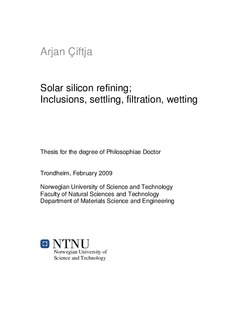| dc.description.abstract | The main objective of the present work is the removal of inclusions from silicon scrap and metallurgical grade silicon. To reach this goal, two various routes are investigated. First, settling of SiC particles from molten silicon followed by directional solidification is reported in this thesis. Then, removal of SiC and Si3N4 inclusions in silicon scrap by filtration with foam filters and wettabilities of silicon on graphite materials are studied.
To supply the increasing needs of the photovoltaic industry it is necessary to produce a low cost silicon feedstock. One of the many routes established from the industry is the Solsilc project. This project aims to produce solar-grade silicon by carbothermal reduction of silicon, based on the use of very pure raw materials. The high carbon content of about 700 mass ppm of the silicon in the form of SiC particles, needs to be removed before the Solsilc silicon could be used as a feedstock to PV industry. Settling of SiC particles in molten silicon was investigated. This part of the work was in cooperation with SINTEF Materials & Chemistry. Two experiments were conducted and the cast silicon ingots were analyzed by light microscopy and LECO carbon analyzer. The results showed that the number of inclusions in the middle of the ingots was less than in the bottom and top. The removal efficiency was above 96% in the middle part of an ingot and the total carbon content measured by LECO was < 25 mass ppm. The difference in density between the particles and the melt gives the SiC particles a relatively high settling velocity leading to a high removal efficiency. Pushing and engulfment of SiC particles by solidification front was also studied. Directional solidification of silicon that followed settling pushes the particles to the top of the ingot. The presence of SiC particles in the middle of the ingot is explained by engulfment.
Top-cut silicon scrap represents a considerable loss of the PV silicon. Removal of inclusions from the silicon scrap would make it possible to recycle it to feedstock in the PV cell production. This was carried out by filtration with ceramic foam filters.
Carbon and SiC foam filters with various pore sizes were employed in the filtration experiments. They were provided by Eger-Sørensen, a Norwegian company and Foseco AB in Sweden. The top-cut silicon scrap came from REC-Scan Wafer.
Characterization of inclusions in silicon scrap before and after filtration experiments took place. Two techniques were developed and used in this work. First, extraction of inclusions by acid dissolution of the silicon was carried out. The SiC and Si3N4 particles collected afterwards were analyzed and counted by automated light microscopy. In the second technique, silicon samples were ground and polished with diamond paste. Microscopic analysis consisted of measuring the surface area of the inclusions found in the silicon samples. Results show that inclusions in top-cut solar cell silicon scrap are needle-like Si3N4 particles and round SiC inclusions. The removal efficiency for a 30 ppi SiC filter is more than 99%. The inclusions remaining after filtration are mainly SiC particles smaller than 10 µm. The experiments show that the filtration efficiency increases with decreasing filter pore size. Some filter cakes that mainly consist of large Si3N4 inclusions are found on the top surface of the filter.
Deep bed filtration is the mechanism responsible for the removal of small particles. After taking into consideration various models for the foam filters the main conclusion is that interception seems to be the main removal mechanism of inclusions in silicon. Settling appears to play a minor role for our system. A new model named branch model explains better the experimental results. Due to the low wetting angle between molten metal and the filter material, capillary forces drive the melt through the filter. Therefore, the melt velocity through the filter is high. This justifies the usage of potential flow in the branch model.
It is shown that molten silicon may be contaminated in contact with the refractories. Since purity for solar cell silicon is crucial, contamination must be minimized. Graphite crucibles may be a source of relatively high levels of Al, Fe, and P. In the filtration process, wettability of the molten silicon with the filter material is very important. Thus, spreading and infiltration of molten silicon into the graphite substrates were also investigated in this thesis. Five different graphites were provided by Svenska Tanso AB. They are in use as refractories in the PV industry and vary from each other in porosity, density, and average pore size. The sessile drop technique is employed to study the wetting behavior of molten silicon on the graphite materials. The measured contact angles show that molten silicon does not initially wet carbon materials. However, due to the chemical reaction between Si and C, a SiC layer is formed in the interface between molten silicon and the graphite. Formation of this layer lowers the contact angles finally reaching equilibrium wetting angles of molten silicon with SiC materials. Spreading of molten silicon is affected not only by the reaction formed SiC layer, but also by the surface finish. The final contact angles, also called equilibrium contact angles, decrease with increasing surface roughness of the graphites. Infiltration of silicon into graphites is mainly related to the average pore size of graphite materials. Materials with large pores are penetrated deeper by the liquid silicon. Zero contact angles of the silicon with graphites are found in materials with both high surface roughness and large average pore size. These results indicate that graphites for use in the PV industry should have a small average pore size. The surface of the graphite in direct contact with silicon should be smooth (low roughness).
| nb_NO |
